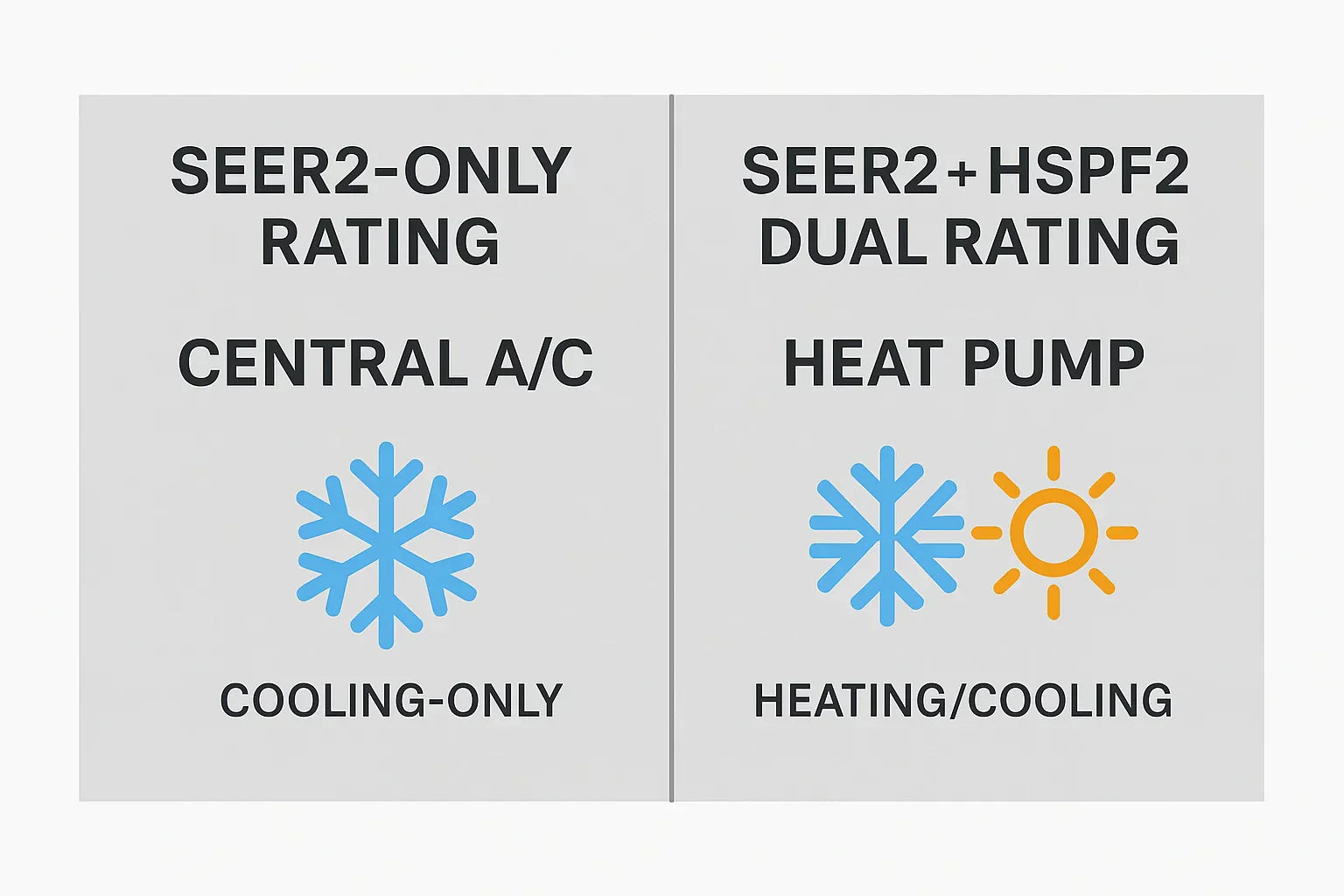When SEER2 became the new cooling efficiency standard, most homeowners assumed it worked the same for every HVAC system. But here’s the thing — while both heat pumps and central air conditioners carry SEER2 ratings, how those ratings apply (and what they mean for your home) is a bit different.
As someone who’s worked on both types of systems in homes across all climates, I can tell you: if you’re choosing between a heat pump and a central AC, understanding SEER2 is only part of the picture. This guide will break down how SEER2 applies to both, where the differences lie, and what really matters when it’s time to buy or upgrade.
What Does SEER2 Measure?
SEER2 stands for Seasonal Energy Efficiency Ratio 2, the latest way to measure cooling performance in HVAC systems. It replaced SEER in 2023, bringing updated testing protocols that reflect more real-world conditions — like duct pressure, airflow resistance, and static pressure.
🔍 Why the Change?
The old SEER rating was based on lab-perfect conditions. But that didn’t reflect how systems actually perform in attics, basements, or tight ductwork. SEER2 adds external static pressure into the testing, which gives a much more realistic look at how your system handles real-world airflow challenges.
SEER2 and Central AC Systems: A Direct Match
Central air conditioners are cooling-only systems. Because they don’t provide heating, SEER2 is the only seasonal efficiency rating that applies.
Typical SEER2 Ranges for Central AC in 2025:
-
13.4–14.3 SEER2 → Entry-level units (meets federal minimums)
-
15–17 SEER2 → Mid-efficiency systems
-
18+ SEER2 → High-efficiency, variable-speed units
Regional Minimums Matter
Depending on where you live, the minimum required SEER2 can vary:
-
North: 13.4 SEER2
-
South & Southwest: 14.3 SEER2 for split systems under 45,000 BTU
📘 Check your region’s SEER2 requirements
For homeowners using AC most of the year — especially in southern states — going above the minimum often pays off in long-term utility savings.
SEER2 and Heat Pumps: One Piece of a Bigger Puzzle
Here’s where it gets interesting. While heat pumps also receive a SEER2 rating, it only applies to their cooling mode. That means a heat pump’s SEER2 tells you how efficiently it cools — not how well it heats.
Enter HSPF2: The Heating Rating
Heat pumps are rated using both:
-
SEER2 for cooling
-
HSPF2 (Heating Seasonal Performance Factor 2) for heating
A good heat pump might have:
-
SEER2: 16.0
-
HSPF2: 8.1
Both values are essential, especially if you're using the heat pump year-round. A high SEER2 means efficient summer comfort; a high HSPF2 means efficient winter warmth.
📘 See top-rated heat pumps on ENERGY STAR
Comparing Heat Pumps vs. Central AC Systems
SEER2 Isn’t Apples to Apples
At first glance, a 16 SEER2 heat pump and a 16 SEER2 central AC seem equivalent — but the heat pump offers heating, too. That year-round value often justifies a slightly higher upfront cost.
Central AC Pros:
-
Lower upfront cost
-
Cooling-only (paired with a separate furnace)
-
Fewer components to maintain
Heat Pump Pros:
-
Cools in summer, heats in winter
-
May qualify for more rebates
-
Works great in mild to moderate climates
Choosing Based on Climate and Usage
🏜️ In Hot, Southern Climates:
-
Central AC + Gas Furnace is often more cost-effective
-
SEER2 matters most — aim for 15.2 SEER2 or higher
-
HSPF2 is less relevant unless winters are cold
🏔️ In Northern or Mixed Climates:
-
Cold climate heat pumps can handle both heating and cooling
-
Look at both SEER2 and HSPF2
-
Consider backup heat or a dual-fuel setup
📘 Learn how SEER2 impacts dual-fuel system efficiency in mixed climates in our main guide:
🔗 What is SEER2 and Why It Matters
Rebates, Tax Credits, and Efficiency Incentives
High SEER2 units can qualify for federal tax credits and state-level rebates, especially when paired with solid HSPF2 ratings (for heat pumps). Many programs require:
-
≥ 15.2 SEER2
-
≥ 7.8 HSPF2
📘 IRS: Energy Efficient Home Improvement Credit
And utilities across the U.S. offer rebates based on SEER2 performance levels — with extra savings for ENERGY STAR-certified systems.
Final Thoughts: SEER2 Is Just the Starting Point
Whether you're choosing a heat pump or a central AC, SEER2 is one of the most important specs to understand — but not the only one. If you’re looking at a heat pump, don’t ignore HSPF2. And if you’re leaning toward central AC, make sure it meets your region’s minimum standards.
SEER2 tells you how efficient your cooling can be — but only when it’s paired with proper sizing, smart controls, and installation best practices.
👉 Next in the Series: What to Expect from SEER3 and the Future of HVAC Efficiency Standards
Alex Lane
Your Home Comfort Advocate







